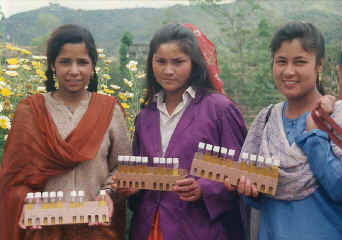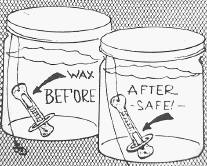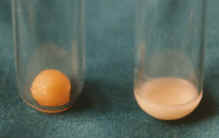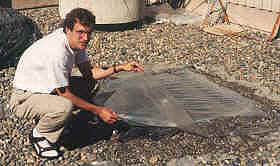Recent Advances in Solar Water Pasteurization
Boiling isn't necessary to kill disease microbes
 The main purpose of solar cookers is to change sunlight into heat which is then used to
cook foods. We are all familiar with how successful solar cookers are at cooking and
baking a wide variety of foods. In this article I want to consider using the heat in solar
cookers for purposes other than cooking. My main focus will be solar water pasteurization,
which can complement solar cooking and address critical health problems in many developing
countries.
The main purpose of solar cookers is to change sunlight into heat which is then used to
cook foods. We are all familiar with how successful solar cookers are at cooking and
baking a wide variety of foods. In this article I want to consider using the heat in solar
cookers for purposes other than cooking. My main focus will be solar water pasteurization,
which can complement solar cooking and address critical health problems in many developing
countries.
The majority of diseases in developing countries today are infectious diseases caused by bacteria, viruses, and other microbes which are shed in human feces and polluted water which people use for drinking or washing. When people drink the live microbes, they can multiply, cause disease, and be shed in feces into water, continuing the cycle of disease transmission.
Worldwide, unsafe water is a major problem. An estimated one billion people do not have access to safe water. It is estimated that diarrheal diseases that result from contaminated water kill about 2 million children and cause about 900 million episodes of illness each year.
Boiling contaminated water
How can infectious microbes in water be killed to make the water safe to drink? In the cities of developed countries this is often guaranteed by chlorination of water after it has been filtered. In developing countries, however, city water systems are less reliable, and water from streams, rivers and some wells may be contaminated with human feces and pose a health threat. For the billion people who do not have safe water to drink, what recommendation do public health officials offer? The only major recommendation is to boil the water, sometimes for up to 10 minutes. It has been known since the time of Louis Pasteur 130 years ago that heat of boiling is very effective at killing all microbes which cause disease in milk and water.
If contaminated water could be made safe for drinking by boiling, why is boiling not uniformly practiced? There seem to be five major reasons: 1) people do not believe in the germ theory of disease, 2) it takes too long, 3) boiled water tastes bad, 4) fuel is often limited or costly, 5) the heat and smoke are unpleasant.
Some examples of the cost of boiling water are worth mentioning. During the cholera outbreak in Peru, the Ministry of Health urged all residents to boil drinking water for 10 minutes. The cost of doing this would amount to 29% of the average poor household income. In Bangladesh, boiling drinking water would take 11% of the income of a family in the lowest quartile. In Jakarta, Indonesia, more than $50 million is spent each year by households for boiling water. It is estimated that in the city of Cebu in the Philippines, population about 900,000, about half the families boil their drinking water, and the proportion is actually higher for families that obtain their water from an unreliable chlorinated piped supply. Because the quantities of fuel consumed for boiling water are so large, approximately 1 kilogram of wood to boil 1 liter of water, and because firewood, coal, and coke are often used for this purpose, an inadequate water supply system significantly contributes to deforestation, urban air pollution, and other energy-related environmental effects.
If wood, charcoal, or dung is used as fuel for boiling water, the smoke creates a health hazard, as it does all the time with cooking. It is estimated that 400 to 700 million people, mainly women, suffer health problems from this indoor air pollution. As a microbiologist, I have always been perplexed as to why boiling is recommended, when this is heat far in excess of that which is necessary to kill infectious microbes in water. I presume the reason boiling is recommended is to make sure that lethal temperatures have been reached, since unless one has a thermometer it is difficult to tell what temperature heated water has reached until a roaring boil is reached. Everyone is familiar with the process of milk pasteurization. This is a heating process which is sufficient to kill the most heat resistant disease causing microbes in milk, such as the bacteria which cause tuberculosis, undulant fever, streptococcal infections and Salmonellosis. What temperatures are used to pasteurize milk? Most milk is pasteurized at 71.7° C (161° F) for only 15 seconds. Alternatively, 30 minutes at 62.8° C (145° F) can also pasteurize milk. Some bacteria are heat resistant and can survive pasteurization, but these bacteria do not cause disease in people. They can, however, spoil the milk, so pasteurized milk is kept refrigerated.
There are some different disease microbes found in water, but they are not unusually heat resistant. The most common causes of water diseases, and their heat sensitivity, are presented in Table 1. The most common causes of acute diarrhea among children in developing countries are the bacteria Escherichia coli and Shigelia SD. and the Rotavirus group of viruses. These are rapidly killed at temperatures of 60° C or greater.
Solar water pasteurization
As water heats in a solar cooker, temperatures of 56° C and above start killing disease-causing microbes. A graduate student of mine, David Ciochetti, investigated this for his master's thesis in 1983, and concluded that heating water to 66° C in a solar cooker will provide enough heat to pasteurize the water and kill all disease causing microbes. The fact that water can be made safe to drink by heating it to this lower temperature—only 66° C—instead of 100° C (boiling) presents a real opportunity for addressing contaminated water in developing countries.
Testing water for fecal contamination
How can one readily determine if the water from a well, pump, stream, etc. is safe to drink? The common procedure is to test the water for bacterial indicators of fecal pollution. There are two groups of indicators which are used. The first is the coliform bacteria which are used as indicators in developed countries where water is chlorinated. Coliform bacteria may come from feces or from plants. Among the coliform bacteria is the second indicator, Escherichia coli. This bacterium is present in large numbers in human feces (approximately 100,000,000 per gram of feces) and that of other mammals. This is the main indicator used if water is not chlorinated. A water source containing 100 E. coli per 100 milliliters poses a substantial risk of disease.
The standard method of testing water for the presence of coliforms and E. coli requires trained personnel and a good laboratory facility or field unit which are usually not present in developing countries. Thus, water supplies are almost never tested.
A new approach to testing in developing countries
In 1987, the Colilert MPN Test (CLT) was introduced as the first method which used a defined substrate technology to simultaneously detect coliforms and E. coli. The CLT comes as dry chemicals in test tubes containing two indicator nutrients: one for coliforms and one for E. coli. The CLT involves adding 10 ml of water to a tube, shaking to dissolve the chemicals, and incubating at body temperature for 24 hours. I prefer incubating tubes under my belt against my body. At night I sleep on my back and use night clothes to hold the tubes against my body.
If no coliform bacteria are present, the water will remain clear. However, if one or more coliforms are present in the water, after 24 hours their growth will metabolize ONPG and the water will change in color from clear to yellow (resembling urine). If E. coli is among the coliform bacteria present, it will metabolize MUG and the tube will fluoresce blue when a battery-operated, long-wave ultraviolet light shines on it, indicating a serious health hazard. I have invited participants at solar box cooker workshops in Sierra Leone, Mali, Mauritania, and Nepal to test their home water supplies with CLT. One hundred and twenty participants brought in samples. In all four countries, whether the water was from urban or rural areas, the majority of samples contained coliforms, and at least half of these had E. coli present. Bacteriological testing of the ONPG and MUG positive tubes brought back from Mali and Mauritania verified the presence of coliforms/E. coli in approximately 95% of the samples. It is likely that soon the Colilert MPN test will be modified so that the test for E. coli will not require an ultraviolet light, and the tube will turn a different color than yellow if E coli is present. This will make the test less expensive and easier to widely use in developing countries to assess water sources.
Effect of safe water on diarrhea in children
What would be the effect if contaminated water could be made safe for drinking by pasteurization or boiling? One estimate in the Philippines predicts that if families using moderately contaminated wells (100 E. coli per 100 ml) were able to use a high-quality water source, diarrhea among their children would be reduced by over 30%. Thus, if water which caused a MUG (+) test were solar pasteurized so it would be clear, this would help reduce the chance of diarrhea, especially in children.
Water pasteurization indicator
 How can one determine if heated water has reached 65° C? In 1988, Dr. Fred Barrett
(USDA, retired) developed the prototype for the Water Pasteurization Indicator (WAPI). In
1992, Dale Andreatta, a graduate engineering student at the University of California,
Berkeley, developed the current WAPI. The WAPI is a polycarbonate tube, sealed at both
ends, partially filled with a soybean fat which melts at 69° C ("MYVEROL"
18-06K, Eastman Kodak Co., Kingsport, TN 37662). The WAPI is placed inside a water
container with the fat at the top of the tube. A washer will keep the WAPI on the bottom
of the container, which heats the slowest in a solar box cooker. If heat from the water
melts the fat, the fat will move to the bottom of the WAPI, indicating water has been
pasteurized. If the fat is still at the top of the tube, the water has not been
pasteurized. The WAPI is
How can one determine if heated water has reached 65° C? In 1988, Dr. Fred Barrett
(USDA, retired) developed the prototype for the Water Pasteurization Indicator (WAPI). In
1992, Dale Andreatta, a graduate engineering student at the University of California,
Berkeley, developed the current WAPI. The WAPI is a polycarbonate tube, sealed at both
ends, partially filled with a soybean fat which melts at 69° C ("MYVEROL"
18-06K, Eastman Kodak Co., Kingsport, TN 37662). The WAPI is placed inside a water
container with the fat at the top of the tube. A washer will keep the WAPI on the bottom
of the container, which heats the slowest in a solar box cooker. If heat from the water
melts the fat, the fat will move to the bottom of the WAPI, indicating water has been
pasteurized. If the fat is still at the top of the tube, the water has not been
pasteurized. The WAPI is
 reusable. After the fat cools and becomes solid on
the bottom, the fish line string is pulled to the other end and the washer slides to the
bottom, which places the fat at the top of the tube. Another pasteurization indicator has
been developed by Roland Saye which is based on expansion of a bi-metal disc which is
housed in a plastic container. This also shows promise and is in the early testing stages.
reusable. After the fat cools and becomes solid on
the bottom, the fish line string is pulled to the other end and the washer slides to the
bottom, which places the fat at the top of the tube. Another pasteurization indicator has
been developed by Roland Saye which is based on expansion of a bi-metal disc which is
housed in a plastic container. This also shows promise and is in the early testing stages.
The WAPI could be useful immediately for people who currently boil water to make it safe to drink. The WAPI will clearly indicate when a safe temperature has been reached, and will save much fuel which currently is being wasted by excessive heating.
 [Editor's note: Using Beeswax & Carnauba Wax to Indicate Temperature: In SBJ #15 we
discussed using beeswax, which melts at a relatively low 62º C, as an indicator of
pasteurization. We have now found that mixing a small amount of carnauba was with the
beeswax (~1:5 ratio) raises the melting temperature of the beeswax to 70º - 75º C.
Carnauba wax is a product of Brazil and can be bought in the US at woodworking supply
stores. Further testing needs to be done to confirm that the melting point remains the
same after repeated re-melting. Write to webmaster@solarcooking.org
and we will send you a small amount of
carnauba wax to experiment with.]
[Editor's note: Using Beeswax & Carnauba Wax to Indicate Temperature: In SBJ #15 we
discussed using beeswax, which melts at a relatively low 62º C, as an indicator of
pasteurization. We have now found that mixing a small amount of carnauba was with the
beeswax (~1:5 ratio) raises the melting temperature of the beeswax to 70º - 75º C.
Carnauba wax is a product of Brazil and can be bought in the US at woodworking supply
stores. Further testing needs to be done to confirm that the melting point remains the
same after repeated re-melting. Write to webmaster@solarcooking.org
and we will send you a small amount of
carnauba wax to experiment with.]
Different strategies for solar water pasteurization
The solar box cooker was first used to pasteurize water. David Ciochetti built a deep dish- solar box cooker to hold several gallons of water. At this time of the year in Sacramento, three gallons could be pasteurized on our typical sunny days.
Dale Andreatta and Derek Yegian of the University of California. Berkeley, have developed creative ways to greatly increase the quantity of water which can be pasteurized, as we will hear about at this conference.
I am also excited about the possibility of pasteurizing water using the simple solar panel cookers. By enclosing a dark water container in a polyester bag to create an insulating air space, and by using lots of reflectors to bounce light onto the jar, it is possible to pasteurize useful amounts of water with a simple system. It takes about four hours for me to pasteurize a gallon of water in the summer with the system I am using. Solar panel cookers open up enormous possibilities for heating water not only for pasteurization, but also for making coffee and tea, which are quite popular in some developing countries. The heated water can also be kept hot for a long time by placing it in its bag inside an insulated box. In the insulated container I use, a gallon of 80° C water will be approximately 55° C after 14 hours. Water at a temperature of 55° C will be about 40° C after 14 hours, ideal for washing/shaving in the morning.
I will close with some advice from the most famous microbiologist, who pioneered the use of vaccinations in the 1890s: Louis Pasteur. When he was asked the secret of his success, he responded that above all else, it was persistence. I will add that you need good data to be persistent about, and we certainly have that with solar cookers; the work in Sacramento, Bolivia, Nepal, Mali, Guatemala, and wherever else the sun shines. Continued overuse of fuelwood is non-sustainable. We need to persist until the knowledge we have spreads and becomes common knowledge worldwide.
For questions or comments contact Dr. Robert Metcalf at rmetcalf@csus.edu.Dr. Robert Metcalf
1324 43rd St.
Sacramento, California 95819 USA.
You can hear some of Dr. Metcalf's speeches here.
An interview with Dr. Metcalf where he discusses water pasteurization is
here. The transcript of this interview is
here.
IDEXX Laboratories, Inc. makes the Colilert kit and is located at this address:
IDEXX Laboratories, Inc.
One IDEXX Drive
Westbrook, ME 04092
USA
Voice: (800) 321-0207 or (207) 856-0496
Fax: (207) 856-0630
Here is their
Web page on the
Colilert System.
 See
also the Solar Puddle Pasteurizer.
See
also the Solar Puddle Pasteurizer.
Editor's Note: Testing Water in Developing Countries
The Colilert system makes it possible to test water without the need for a laboratory. IDEXX Laboratories, the manufacturer, recommends that you use five test tubes for each sample. Bob Metcalf explains that five tubes would comprise 50 ml, which is the minimum sample size permitted by US law. This is an unrealistically high standard by which to judge the water in developing countries where you are examining water that is already being drunk, in spite of the fact that it may be making people sick. By using a single test tube (10 ml) there is a very small chance that your sample missed the small number of bacteria that might have been present.
IDEXX Laboratories will also tell you that you need an incubator to achieve valid results. Again, Bob Metcalf tells us that all that is needed is to keep the tubes close to your body for 36 hours, since body temperature is the correct incubation temperature.
What you are actually measuring in the test is the presence of 1) coliform bacteria, and 2) E. coli, a type of coliform bacteria that is largely found in fecal matter. A positive test for coliform bacteria might be due to coliform bacteria that has washed off of plant leaves , and thus be fairly innocuous. A positive test for E. coli, however, would indicate that any bacteriological contamination was from a fecal source, which might also contain Giardia, cholera, or other serious infectious microbes.